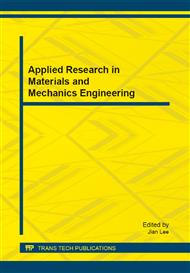[1]
Hasanbeigi, A., Price L. Lin E. Emerging energy-efficiency and CO2 emission-reduction technologies for cement and concrete production: A technical review. Renewable and Sustainable Energy Reviews 2012, Vol. 16, pp.6220-6238.
DOI: 10.1016/j.rser.2012.07.019
Google Scholar
[2]
Lothenbach, B., Scrivener K. Hooton RD. Supplementary cementitious materials. Cement and Concrete Research 2011, Vol. 41, pp.1244-1256.
DOI: 10.1016/j.cemconres.2010.12.001
Google Scholar
[3]
Scrivener, K. L., Nonat A. Hydration of cementitious materials, present and future. Cement and Concrete Research 2011, Vol. 41, pp.651-665.
DOI: 10.1016/j.cemconres.2011.03.026
Google Scholar
[4]
Feng, N. Q., Peng, G. F.: Applications of natural zeolite to construction and building materials in China. Construction and Building Materials 2005, Vol. 19, 579–584.
DOI: 10.1016/j.conbuildmat.2005.01.013
Google Scholar
[5]
Karakurt, C., Topcu, I. B. 2011. Effect of blended cements produced with natural zeolite and industrial by-products on alkali-silica reaction and sulfate resistance of concrete. Construction and Building Materials Vol. 25, 1789-1795.
DOI: 10.1016/j.conbuildmat.2010.11.087
Google Scholar
[6]
ČSN 72 0102: Basic analysis of silicates - Determination of loss by drying. Czech Standardization Institute. Prague (2009).
Google Scholar
[7]
ČSN 72 0103: Basic analysis of silicates - Determination of loss on ignition. Czech Standardization Institute. Prague (2009).
Google Scholar
[8]
ČSN EN 12350-2 Testing fresh concrete: Slump test. Czech Standardization Institute. Prague (2000).
Google Scholar
[9]
Roels, S., Carmeliet. J., Hens. H., Adan. O., Brocken, H., Černý, R., Pavlík, Z., Hall, C., Kumaran, K., Pel, L., Plagge, R. Interlaboratory Comparison of Hygric Properties of Porous Building Materials. Journal of Thermal Envelope and Building Science 2004, Vol. 27, pp.307-325.
DOI: 10.1177/1097196304042119
Google Scholar
[10]
ČSN EN 12390-3 Testing of hardened concrete – Part 3: Compressive strength. Czech Standardization Institute. Prague (2002).
Google Scholar
[11]
ČSN EN 12390-5 Testing of hardened concrete – Part 5: Bending strength. Czech Standardization Institute. Prague (2007).
Google Scholar
[12]
Vejmelková, E., Pavlíková, M., Jerman, M., Černý, R. Free Water Intake as Means of Material Characterization. Journal of Building Physics 2009, Vol. 33, pp.29-44.
DOI: 10.1177/1744259109104069
Google Scholar
[13]
Kumaran M. K.: Moisture Diffusivity of Building Materials from Water Absorption Measurements. Journal of Thermal Envelope and Building Science. 1999, Vol. 22, pp.349-355.
DOI: 10.1177/109719639902200409
Google Scholar
[14]
Applied Precision – ISOMET. [User manual], Bratislava, (1999).
Google Scholar


